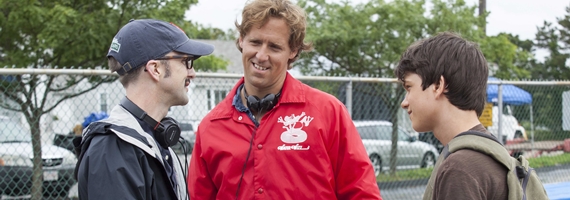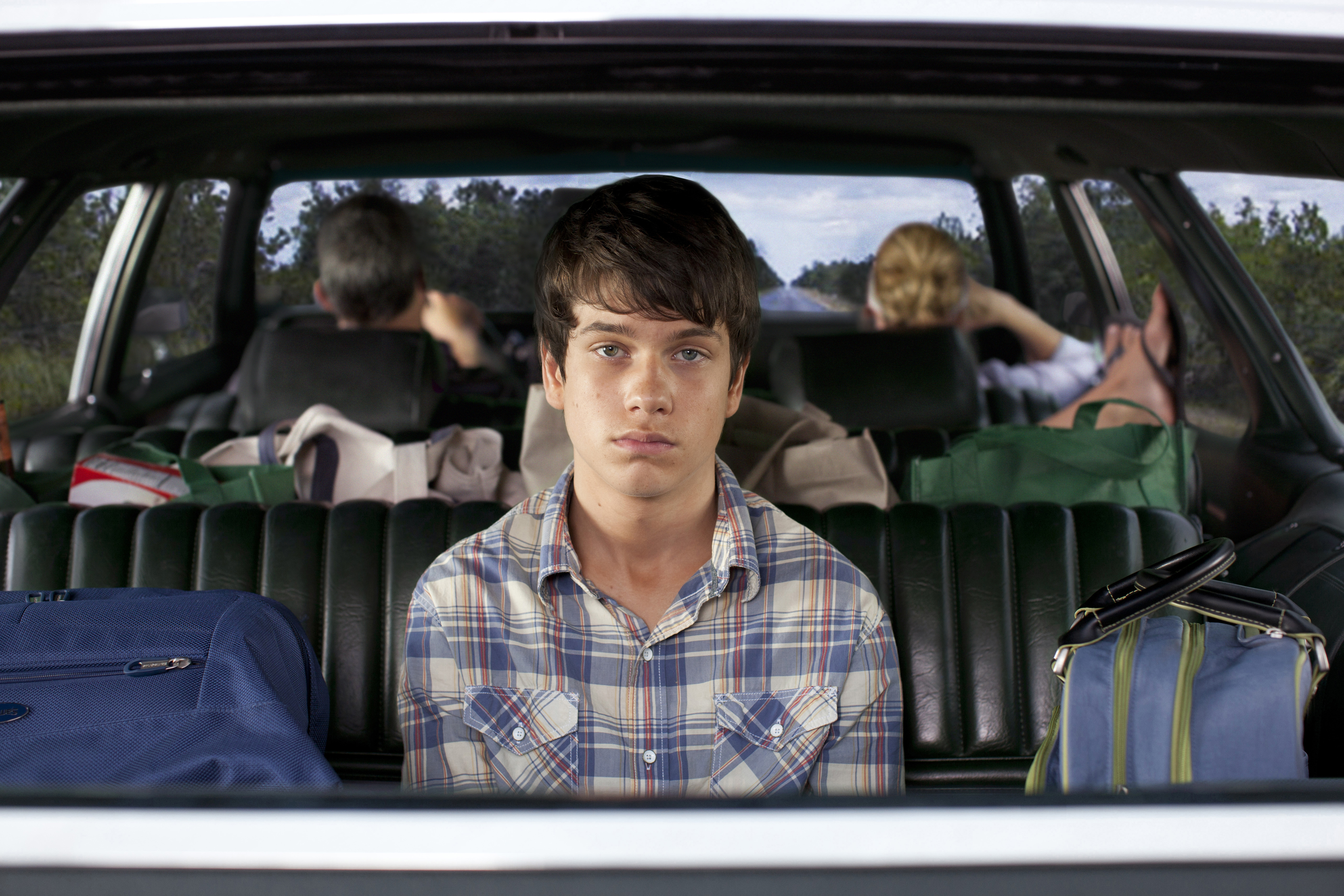
It rained off and on Monday afternoon in the Nations Capital and I found myself on the cusp of running late to a press junket for The Way, Way Back. The Way, Way Back is a summer coming of age tale written and directed by Academy Award winners Nat Faxon (The Descendants, Ben and Kate) and Jim Rash (The Descendants, Community), both of whom I was scheduled to interview. I ended up being three minutes late because Google Maps likes to play games and take you to roads that don’t exist. Thankfully, I was able to park at the hotel and as soon as I set foot in the lobby I was whisked to an elevator and sent to the fourth floor of the Four Seasons on Northwest Pennsylvania Avenue.
A plush carpeted hallway led me from the elevator to a group of four other people standing anxiously outside of the room where we would be interviewing. No one spoke and my nerves crept in, turning my excitement into fear and an instant feeling of ‘I need to leave or I’m gonna vomit’. But before I could back out and proceed to vomit on the plush carpet, the door opened and we were greeted by a blonde representative inviting us in. As I walked closer to the door, I could only equate the feeling of entering the unknown to what Charlie must have felt entering the chocolate factory.
The floor was a green and crème colored floral pattern and the walls were a lighter shade of crème. We walked past a bedroom area, a bathroom hallway, and into a back living room area, staged with a couch, a semi-circle of 5 chairs, and two posters for the film. The light coming in from the rain-covered window spotlighted the couch where Nat Faxon and Jim Rash sat, before rising to their feet to greet us. It took everything inside of me not to grin like an idiot from ear to ear. Jim was dressed “Dean-Like”, with navy blue slacks, lighter blue button-up shirt, grey-flannel skinny tie (which matched his iPhone case) clay brown shoes, and his dark tortoise glasses. I felt like I was at FTS Headquarters watching an episode of Community. I walked towards Jim, and like the other interviewers before me, extended my hand.
“Hi, I’m Nick”
“Jim, nice to meet you.”
“Oh, I know who you are,” is what I wanted to say, but I didn’t. I leaned past Jim, extending my hand towards Nat.
“Hi, I’m Nick”
“Hey, Nat, nice to meet…”
It’s at this point our hands accidentally bumped Jim’s head as he sat down, we apologize and the idle chit-chat dissipated as the interview began. Rash sat on the right side of the couch within arms reach of his two-fifths filled bottle of VOSS. A few more feet away stood a room service cart with an ice bucket covered in condensation, a ginger ale, two glass-bottled Cokes, and one glass-bottled Diet Coke. Nat held an empty Fiji water bottle for most of the interview before sitting it aside on the table stand near him. Nat and Jim both admitted they hadn’t been to DC in years, believing their last visits were on a high school trips. Jim grew up in North Carolina, and Nat grew up in Massachusettes, but both, living on the east coast, had an affinity for water parks which was half of the reason for the film’s premise and location. The other half was some character inspiration and personal experience.
The Way, Way Back opens with an awkward car ride as Duncan’s mother’s boyfriend Trent asks Duncan on a scale of one to ten, what is he? Duncan reluctantly says six and Trent quickly shuts that notion down by saying he’s a three; establishing the relationship these two characters share and what the tone of the film will be. That scene comes verbatim from a personal experience that Rash shared with his stepfather on a family trip to Michigan. So from the beginning, Rash and Faxon knew where to begin the film but getting to the end was a process all it’s own. The Way, Way Back took eight years to complete. As the years went by, the story’s core and family dynamic was “beefed up a little bit more” for dramatic purposes and the rest evolved as time went by, with character roles expanding and shrinking.
NF: Caitlin for example was someone that we created a bit more for, especially since we cast Maya Rudolph who is an old, old friend of ours. [We] Just tried to give the relationship between Owen and Caitlin a little more depth. Surprisingly Jim’s character,
JR: Got bigger
NF: Got a lot bigger… strange how that worked out. (laughs)
JR: We tested the script and people said I’d love to see more of this Lewis character and just, weirdly, it was me.
Even though it took eight years, they felt it allowed them a lot of time to go over the script. It allowed them to pull back and “say more with silence” which, Duncan does by having little to no dialogue for nearly the first half of the film. They use the silence to pull out emotions that teens are feeling but are having a hard time expressing. Duncan, through most of the film, is trying to figure out how to cope with the idea that his mother, who he is close with, is being pulled away by this other force (Trent). That is what sends this character out into the world, developing new relationships and looking for that role model, which he eventually finds, to a degree, in Owen (Sam Rockwell). Rash and Faxon walk a fine line, balancing out the emotions and restraint of all their characters. By walking that line, they create characters that feel real and believable.
ME: When you guys were directing the film, the opening scene were he’s (Duncan) in the back and you only see Steve Carell’s eyes (Trent) through the rearview, I thought that was really, really cool. Did you guys, when directing, intentionally or unintentionally adopt anyone’s particular style that you worked with before like Alexander Payne, did you learn anything from him or any directors that you liked.. or, what was… I guess feel or tone that you were going for?
JR: I don’t think we would directly like anything to someone. We certainly sought out information and advice from any and everyone that would contribute who had done this, from first time directors to second time to beyond. And certainly as actors we always sort of, maybe, in the back of our heads made note of certain things that we appreciated from directors we had worked with. I think that in working with, for us, particularly in working with John Bailey, our director of photography, who’s got a laundry list of movies from Ordinary People to Groundhog Day to everything, it really was us just sitting down and talking about the script and what we wanted it to feel like. The things we all connected on with John was the claustrophobia of the house for Duncan, and the sense of entrapment there and then the expansiveness and feel of this water park and the feel of emotion and the feel of life. In the car we talked about not unveiling Trent until we got out of the car, except for his eyes. Stylisticly, I think we’re very much ready to jump in and start honing our own sort of experiences as directors. I think we wanted to concentrate on what was the best way to tell the story, and I think the best thing we could do for this particular outing was knowing the story and talking to our actors about the intentions of these scenes, what’s behind them, what’s the stake, what are these moments, and I think that’s where our strength lies as our first time out. And then as we get more into it, I think it will be fun to find that thing that a lot of seasoned directors have been nurturing for years, especially an Alexander Payne type person who has a few films but has a very distinct approach and style to his movies.
After my question, we went back to the other side of the semi-circle of chairs for another round of questioning. Jim Rash was congratulated on Community being green lit for a fifth season and was asked about writing the Basic Human Anatomy episode of Community, his first television show script, how he came up with the idea, and what the inspiration was for the episode.
“Basically I went up into the writers room about two weeks prior, or a little bit more, before I was supposed to be sent off to write the script. I took a few ideas to them because we sort of had this… they had an available storyline and we talked only about breaking up Troy and Brita. That’s the only thing that had to happen in that, in my episode. So with that in mind, we sort of started talking about, I just threw out Freaky Friday something. And randomly one of the writers said ‘Oh my god, we’ve talked about body switching for every season, and we didn’t have a way to make it work.’ Just by that conversation we realized this felt like a great way for our characters to break up with each other. To see Troy as a man struggling with becoming a man, and not able to face this task of breaking up with Brita and utilizes the idea that Abed would do it for him as him. For me, I love the Community episodes where, while we have paintball, I love the ones that move our characters into this little dramatic place, so once we fleshed out that whole story, I was off to write.”

Check back later today for the continuation of my interview with Nat Faxon and Jim Rash where the further discuss The Way Way Back, bad summer jobs and how the two approach the creative process.



